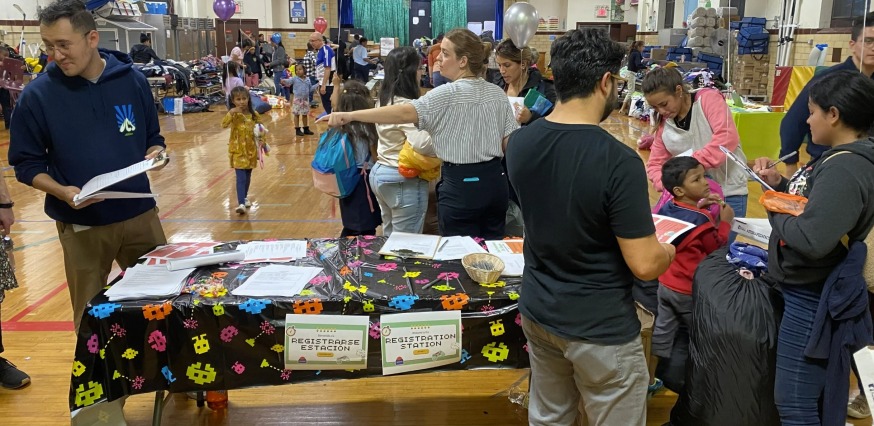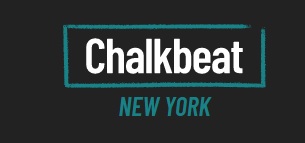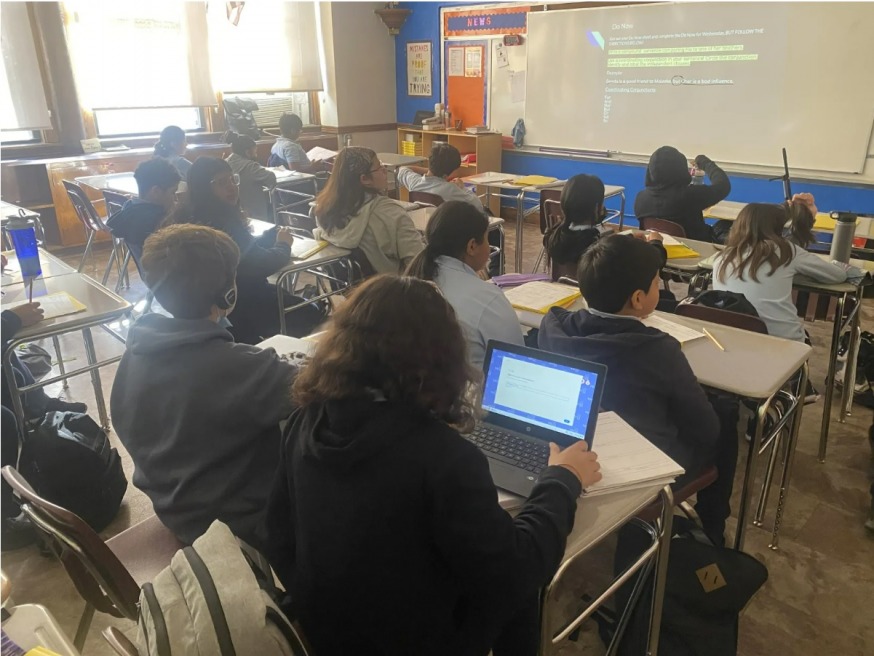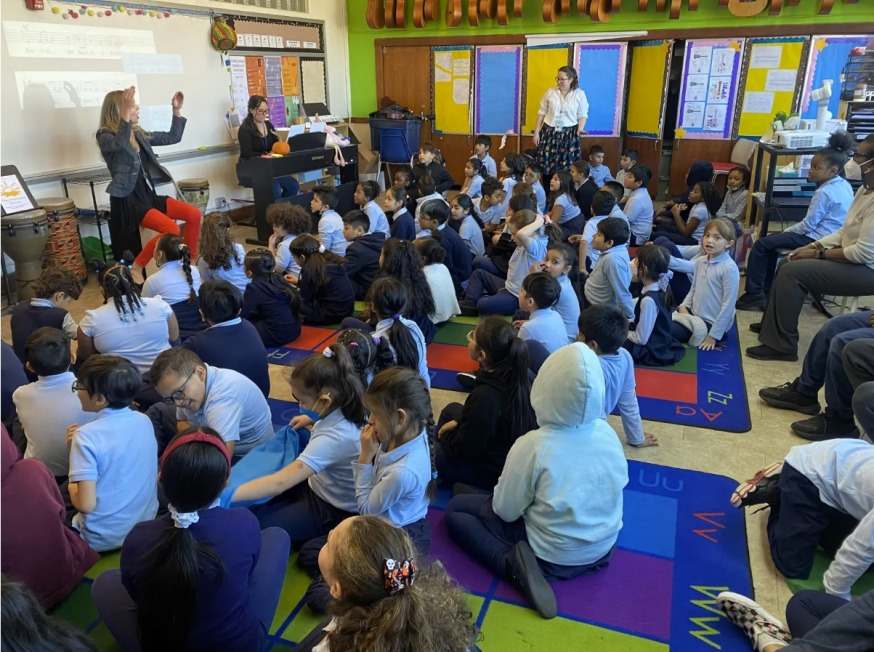
Staff and parents at VOICE charter school in Queens help families at a supplies giveaway, part of an “all-hands-on-deck-effort” to welcome 70 asylum-seeking students. Michael Elsen-Rooney / Chalkbeat
 This article was originally published by Chalkbeat New York on Nov. 28By
This article was originally published by Chalkbeat New York on Nov. 28By
On a Friday night in early November, roughly two dozen families at VOICE charter school in Long Island City, Queens, were preparing for a New York winter — most for the first time in their lives.
In the school’s ground floor gymnasium, parents who had recently migrated from Venezuela and other Latin American countries to seek asylum in the U.S. perused tables stacked high with warm winter gear, pots and pans, and school supplies. Students in light blue uniforms munched on pizza and played with toys and balloons.
Ingles Moreno, the mother of a seventh grader at VOICE who arrived with her daughter in New York City in late August after fleeing Venezuela, surveyed her suitcases and garbage bags full of new supplies.
“I feel happy,” said Moreno, who is living at a nearby homeless shelter. “I didn’t have [winter clothes], and now thank God I do.”
The Friday night giveaway was part of what school staffers describe as an “all-hands-on-deck” effort to accommodate an influx of dozens of new migrant families at VOICE, a K-8 school of around 650 students, 84% of whom receive free or reduced-price lunch.
The enrollment rush began as a trickle in the summer and quickly picked up steam as families referred each other to the school or got recommendations from local shelters and social service organizations. A proliferation of hotels in recent years in Long Island City led to a cluster of newly converted homeless shelters in the school’s backyard.
Pandemic-related enrollment declines left VOICE with extra space, and the school wound up enrolling an estimated 70 asylum-seeking children, said principal Franklin Headley.
Across the city, an estimated 7,200 students living in homeless shelters have enrolled in public schools since July, many of them asylum-seekers sent on buses by Texas Gov. Greg Abbott, education department officials said last month. In the neighborhood on the border of Astoria and Long Island City where VOICE is located, several schools saw dramatic influxes: The public elementary school that shares a building with VOICE’s younger students also enrolled about 70 asylum-seeking kids, according to education department budget records.
Officials didn’t have an estimate of how many migrant students have enrolled in publicly funded, privately run charter schools like VOICE.
At VOICE, their arrival profoundly reshaped the school almost overnight.
The school, which does not have dedicated dual language programs and got no advance notice of the new arrivals, has scrambled to meet the material, educational, and emotional needs of students and parents. Staffers acknowledge it’s still a work in progress.
“I’m really proud of my teachers,” said Headley. “It’s hard when they see so many children in the class and not quite knowing what to do.”
And while the past few months at VOICE have been taxing, they’ve also been inspiring, Headley said. They’ve given the school an injection of new students at a time of faltering enrollment, and given existing families and staff a shared purpose in helping the new arrivals.
“I think there’s been a narrative out in the news a little bit that maybe schools are panicked about this,” Headley said. “I think for us, it’s like these kids are a gift.”
Teachers adjust their expectations
The number of the school’s homeless students leapt from under 1% last year to 10% this year, school officials said. VOICE previously served English language learners — about 16% of its students were classified as such last year. That number jumped to about 27% this year, nearly half of whom are classified as beginners, Headley said.
But numbers alone didn’t communicate the scope or complexity of what the school was about to face. It was only when staff started conducting more detailed intake interviews that a fuller picture of the families’ needs started to emerge, said Peter Cataldo, a social worker who’s been at VOICE for 12 years.
“An influx of children who don’t speak English is very new for us,” he said.
Families often arrived with little more than the clothes on their backs, school social workers learned. Few were prepared for winter, and they had scant options for cooking food or washing their clothes in the shelters. Many kids didn’t have the immunizations required to attend school in New York City, and parents were anxiously searching for ways to earn money without work permits as they awaited immigration hearings, which were often scheduled in other states.
Administrators tried to distribute the newly arrived students as evenly as possible across multiple classrooms so that no single teacher had a critical mass.
VOICE had two dedicated English as a new language teachers prior to this school year, and hired another this year. But those educators don’t lead their own classes, instead helping out in existing classes or pulling out small groups of students to offer supplementary support.

An English as a new language teacher works with two recently arrived immigrant students at VOICE charter school in Queens. Michael Elsen-Rooney / Chalkbeat
The first few weeks were a blur of trial and error.
At first, some classroom educators translated every word of their lessons into Spanish, but quickly learned that was too impractical and time consuming, said Matt Kolman, VOICE’s middle school dean.
Then some teachers started leaning on students who were fluent in both English and Spanish to buddy up with the newcomers to help translate. But the bilingual classmates found themselves missing most of the lesson trying to help out their peers.
Ultimately, many educators settled on a more limited approach — translating key words and assignments, allowing students to use an automated computer program that translates English audio to Spanish in real time, and setting up “translation stations” with computers that students can check into at their discretion.
“I’m in my 10th year at VOICE, and in some ways, it’s like going back to like being a new teacher,” said Danny Powell, who teaches seventh and eighth grade social studies.
The city education department shelled out $12 million in additional funding last month to roughly 370 city public schools that enrolled asylum-seeking students, but charter schools weren’t included in that allocation.
Headley said the school has relied on a group of schools convened by the New York City Charter School Center that meets monthly to learn about serving English learners, and tried to pass some of that knowledge along to administrators and teachers.

Middle school students use headphones and laptops to help with translation during a class at VOICE charter school. Michael Elsen-Rooney / Chalkbeat
One of the hardest lessons for staff has been accepting that the pace of learning may look very different.
Teachers have had to learn to “pump the brakes a little” and accept that “get[ting] them settled in the country, building language, making community … is just as important as what they’re learning,” said Cataldo, the social worker.
The steep challenges, however, have made the small victories and moments of joy even sweeter.
One middle school student, an aspiring future actor who migrated from Colombia, was able to define the word “personification.” Another group of kids let loose on a class field trip to the Statue of Liberty. Seeing them “be kids, feeling accepted and safe and welcome,” was deeply gratifying, said Powell.
‘Peeling back the layers’: Students share their stories
Nearly three months into the school year, staffers are still carefully working to gain the trust of students and parents struggling with memories of traumatic border crossings.
“Some students … are carrying a lot with them, whether they left family members behind, a few who have … encountered death along the way,” said Cataldo, the social worker. “We’re really just peeling back the layers of the onion right now.”
Four middle school students who spoke with Chalkbeat on the condition of anonymity described grueling and perilous journeys that remain fresh in their minds.
One sixth grader described getting swept up in a strong current while crossing the Rio Grande, and being separated from her mother and siblings, who remained in Mexico for several days while the preteen was in detention in the U.S.
“I went three days without seeing her and knowing nothing about what happened to my siblings,” the student said.
“There were a lot of deaths out there in the forest, the desert,” said another middle school student, who journeyed to the U.S. with family members, including a 5-month-old cousin. “My little cousin almost drowned.”
Several of the students said they were still traumatized by elements of the journey and think about it often.
The school has several built-in advantages responding to emotional and mental health challenges, including six social workers on staff.
“The kids want to talk, want to tell you their story,” said Cataldo, the social worker.
One of his colleagues who doesn’t speak Spanish called a city-sponsored phone translation service, “sat the phone right there in the middle, and an hour-and-a-half later got like this whole story, just this wonderful opportunity for this kid to just share what they were carrying,” Cataldo said.
Educators and parents provide wraparound support
The school has focused on integrating the new students into social and extracurricular activities, encouraging soccer players to join the school’s team and trying to create opportunities for the new arrivals to build friendships with students who have been at the school for years.
Staffers and parents at the school have been trying to figure out what the school could help with directly, and what kinds of services it could help link the families to through community partners.

Students participate in a music class at VOICE charter school. The school has focused on integrating new students into social and extracurricular activities. Michael Elsen-Rooney / Chalkbeat
Karina Chalas, the head of middle school operations, and one of a limited number of bilingual staffers, forged relationships with staff in the shelters, giving the school a better understanding of the conditions families were facing.
Chalas soon learned that parents were struggling with what to do with their kids in the afternoon. Shelter rules prohibited kids from staying alone in their rooms – so the school made a push to enroll the new arrivals in after-school programs.
The school’s parent leaders — some of whom arrived in New York City as immigrants themselves — also leapt into action.
“To me it’s very personal. I came here in 2000 from another country, and Astoria is such a great community,” said Aniko Domokos, the corresponding secretary of the parent association. “I just want these people to feel the same way … of I was so welcomed, and found my place here.”
Looming over all of the school’s efforts to support the migrant students is the question of how long they will stay.
Many of the families are looking for permanent housing, but may wind up in far-flung corners of the city, or they have court dates that will take them to other states. The school loses funding if students drop from its roster, making any big additional investments something of a financial risk.
But Headley, the school’s principal, says he’s trying not to worry about what the future holds.
“We don’t know how long they’re going to be with us,” he said. “They’re here now, let’s make the most of it.”
Michael Elsen-Rooney is a reporter for Chalkbeat New York, covering NYC public schools. Contact Michael at melsen-rooney@chalkbeat.org.
